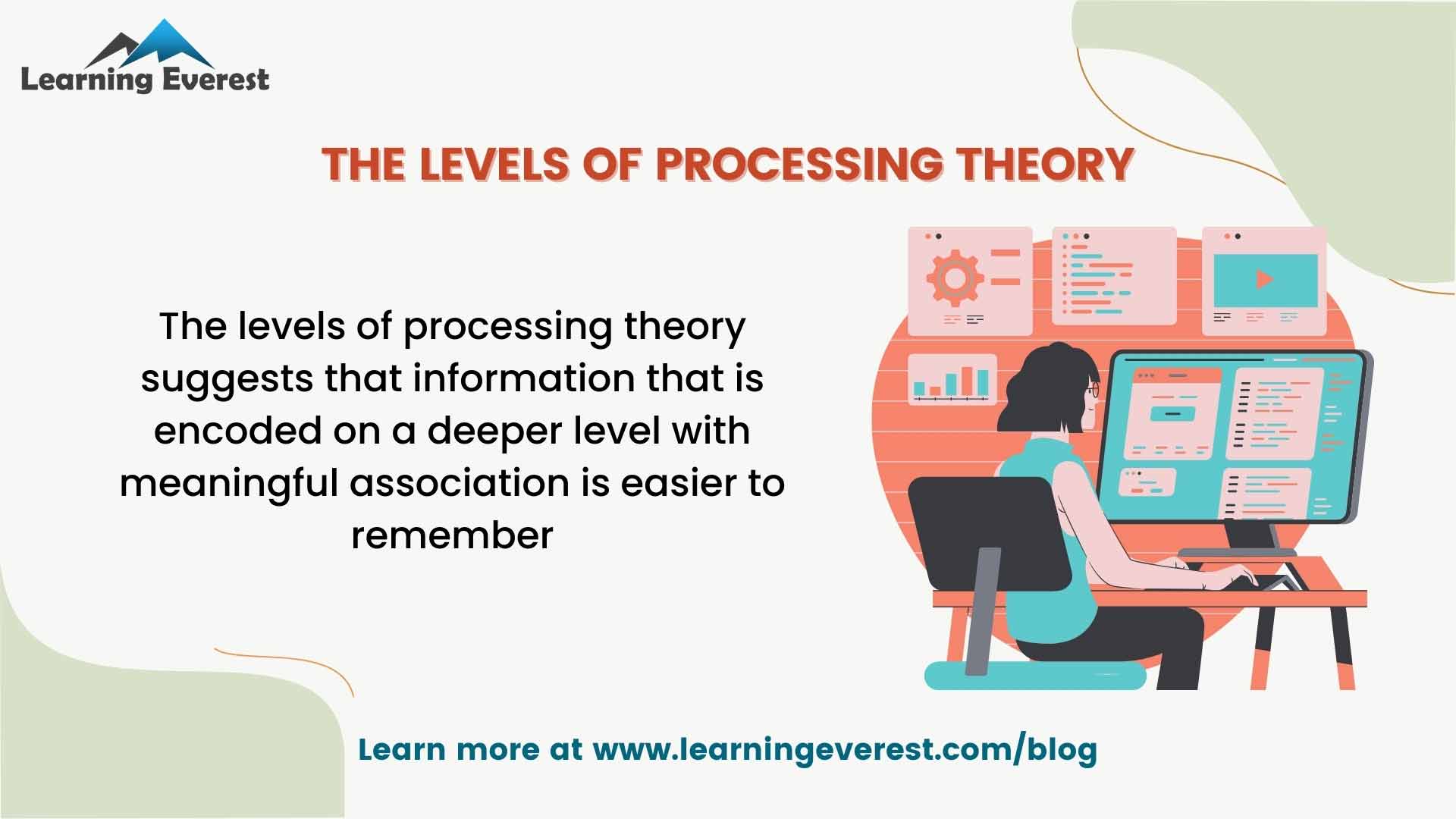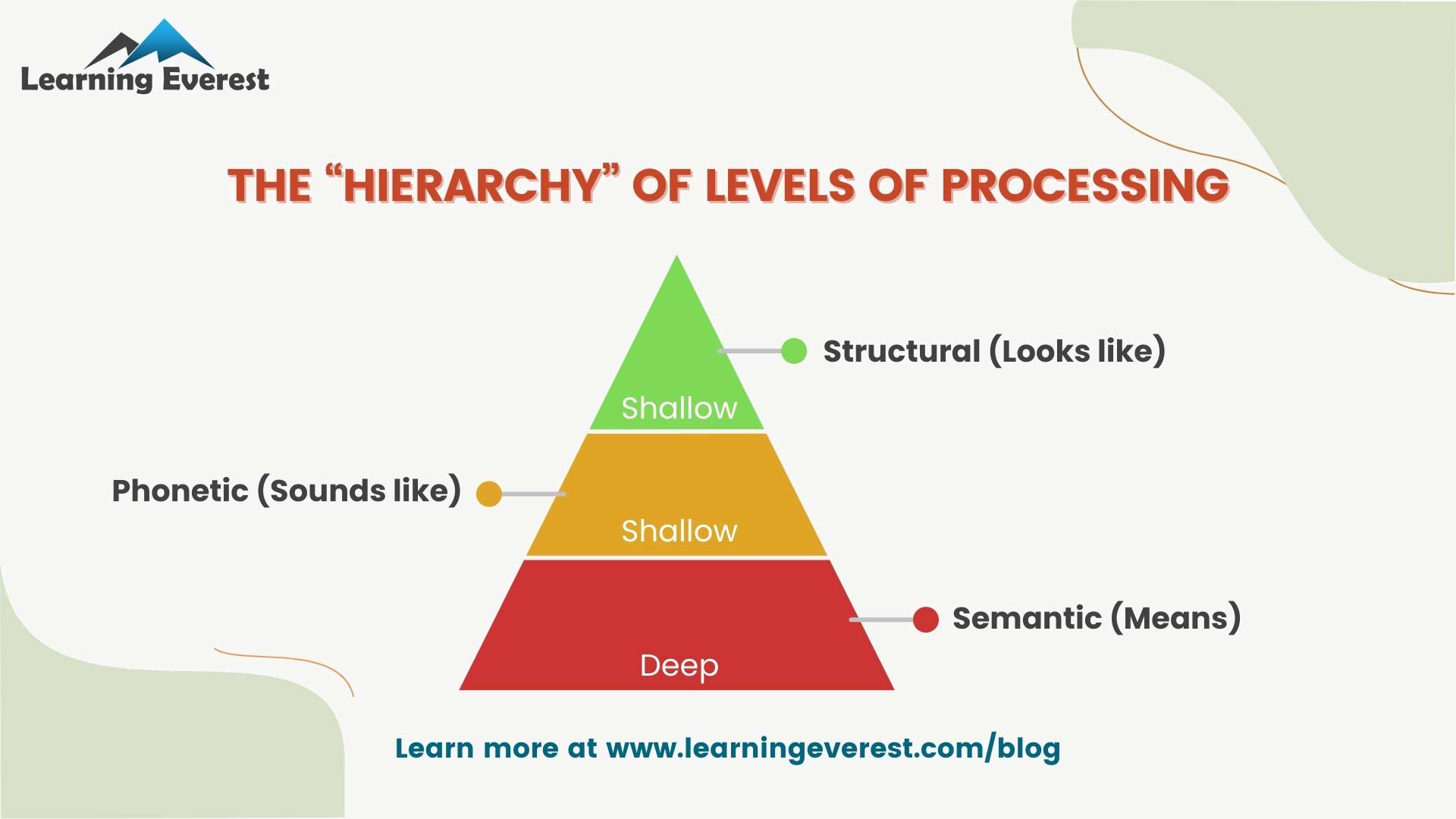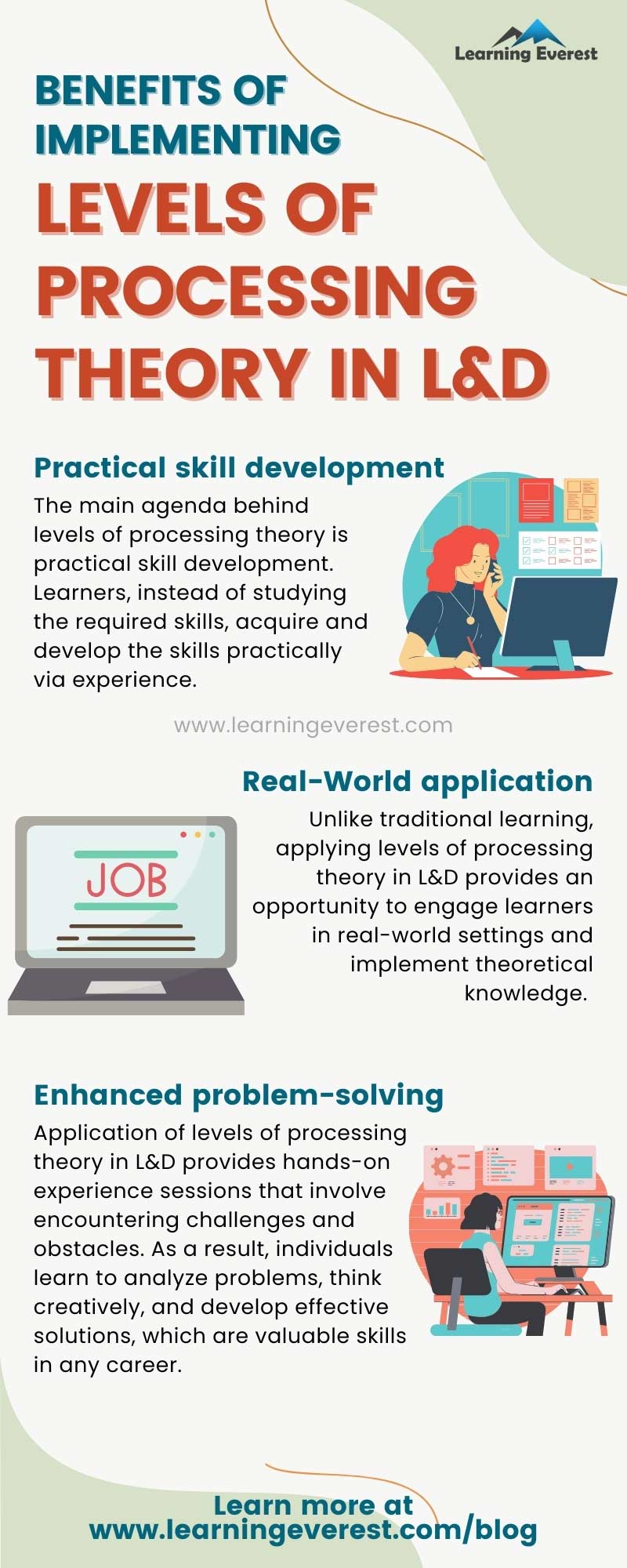Have you ever wondered why we remember the information that we attach significance to better than the information we repeat? Understanding the way that we process and store knowledge could reveal important answers about how our cognition works, how we form our perception of the world, and how to create a better life for ourselves. If this sounds interesting to you, keep reading!
Table of Contents
- What is the levels of processing theory?
- The history of levels of processing theory
- Applying levels of processing theory to learning and development programs
- Limitations of levels of processing theory
- Infographic
- Knowledge check!
- Frequently Asked Questions (FAQs)
- Q: What is the levels of processing theory?
- Q: What is levels of processing theory in learning?
- Q: Who developed the levels of processing theory?
What is the levels of processing theory?
The levels of processing theory is based on the concept that the method by which information is encoded in our brain affects how well it is remembered. The levels of processing theory counters the idea that mere repetition helps us remember information long-term. Instead, the theory suggests that information that is encoded on a deeper level with meaningful association is easier to remember.

The Levels of Processing Theory
In a nutshell, the levels of processing theory suggests that, in the long run, repetition is insufficient for long-term memory. Instead, we must encode information semantically by associating it with other ideas and knowledge. This encodes the gained information on a deep level and is a more effective learning technique.
The history of levels of processing theory
The levels of processing theory was developed by Fergus Craik and Robert Lockhart in 1972 as an alternative to the theories of memory that hypothesized separate levels for sensory, working, and long-term memory. The levels of processing theory focuses on the depth of processing involved in memory, and suggests the deeper the information is processed, the longer a memory of the information will last. The central idea is that incoming stimuli are subjected to a series of analyses, beginning with shallow sensory levels and proceeding to deeper, more complex abstract and semantic analysis.
Craik and Lockhart’s main theoretical assumptions were:
- The level or depth of processing of a stimulus has a big effect on its memorability
- The deeper level of processing produces more elaborate, long-lasting, and stronger memory trails than do shallow levels of processing
Therefore, instead of focusing on the stores or structures involved, this theory focuses on the levels of processing involved in memory. This theory uses a pyramid to show the “hierarchy” of different levels of processing:

The “Hierarchy” of levels of processing
Let’s discuss one by one.
1 – Structural processing
Structural processing happens when we encode the physical features of something. Like, we are noticing the color of a written text or whether or not it’s in all capitals. Structural processing includes taking a stimulus’ (the information) color, size, shape, or physical form. This type of processing doesn’t need too much deep thought. We simply encode the stimulus for what it is.
2 – Phonemic processing
Phonemic processing is a bit higher than structural processing but is still a shallow level of processing information. It occurs when we take in sounds. Imagine you are looking at a list of words: cat, table, window and pencil. And you are asked which one rhymes with “label”. To answer correctly, you will need to sound out each of the words in your head, count syllables or compare it to the sound of the word “label”. Although phonemic processing is still considered a mere shallow form of processing, it often has a higher recall rate than visual processing.
3 – Semantic processing
The deepest form of processing in the levels of processing is semantic processing. It involves processing information with the understanding of the word in its full meaning. To explain it further, if structural processing encodes the font color of the word “label” and phonemic processing encodes the sound of this word, semantic processing encodes what the meaning of a label is, how it relates to other words and objects around it, etc. This is because semantic processing goes deeper than mere physical appearance or auditory information; therefore, we encode it better.
Now that you know how the information processing theory works, you are ready to start making it a staple of your corporate training. Keep reading!
Applying levels of processing theory to learning and development programs
Speaking of, it is time to take this method and apply it to corporate training. Below are three practical ways you can turn the psychology of this theory into workplace practice.
1 – Grab your learners’ attention with sensory details
First, we know that you need to use sensory details to grab your audience’s attention. And since some of your audience might have different sensory strengths (i.e., they may be visual, auditory, reading/writing, or kinesthetic learners), you need to engage with multiple senses throughout your training. Understanding how learners absorb knowledge, make sense of learning modules, and retain information will help you create an enriching learning culture that supports and engages your learners with less frustration.
Still confused? You can read our blog on VARK for more details.
2 – Be clear about your key concepts
Just like you are not going to remember every word of this article, your employees won’t remember every piece of information thrown at them during training programs. Therefore, rehammering key concepts during the learning journey is important because it helps reinforce the material. Just like hearing a song repeatedly helps you remember the lyrics, revisiting ideas solidifies them.
It ensures you don’t just understand the concept briefly but truly grasp it long-term. Building on repetition, you can also ask attendees to perform active recall exercises. These are activities that put their new knowledge to work — it might mean educating a fellow colleague on what they learned or doing an internal presentation to the rest of their team. Plus, each repetition brings new insights or connections, making the learning experience richer and more comprehensive.
But to do you need to be clear about the learning objectives. Read our blog on How to write learning objectives using Bloom’s taxonomy.
3 – Encourage project-based learning opportunities
As mentioned earlier, repetition is not enough. Learners need to semantically encode the information by relating it to other ideas or knowledge. To do so, you can introduce project-based learning in your L&D programs. Project-based learning is the prominent learning method that can be implemented. In this method, learners are indulged in doing projects related to any particular concept wherein the learners will have to research and come up with a suitable outcome. It is like building a web of understanding where each new piece of knowledge links to what they already know, deepening their comprehension and retention. Plus, it is way more engaging and fun!
- You can develop scenario-based learning that requires learners to apply their knowledge to solve problems. This could involve role-playing or simulations where they must navigate real-life complexities using what they have just learned.
- You can also incorporate game elements like points, badges, levels, and leaderboards into projects, wherein learners are indulged in playing conceptual games and simulation. This helps them know the concept, analyze, understand, and ideate.
- Adventure-based learning is another learning strategy where the learners can be directly involved in real-time learning practices such as industrial visits, implant training, outdoor education activities, group task-completing activities, etc.
Having said that, this theory also does have a few limitations.
Limitations of levels of processing theory
- The theory does not give enough credit to how the environment affects memory retrieval.
- It overlooks that some people are naturally better at remembering things, regardless of how deeply they process the information.
- While it says long-term memory is affected by how deeply and distinctively we process information, it does not clearly explain how these factors work together or which one is most important.
- It does not consider the role of attention in forming memories. Being able to focus is crucial for remembering things well.
- The theory needs to better explain why deep processing helps us remember things more effectively.
Still the levels of processing theory is an effective approach to take when the goal of learning is to create meaningful changes in learners’ core understanding of and handling of a particular topic. It facilitates deep engagement with learning materials which in turn ensures that the learnings stick for a long time to come and produces significant changes in learners’ skill-set and behavior.
To learn more, check out our this blog as well:
How The Levels of Processing Theory Can Make E-learning More Immersive
Infographic
Knowledge check!
Frequently Asked Questions (FAQs)
Q: What is the levels of processing theory?
A: The levels of processing theory is based on the concept that the method by which information is encoded in our brain affects how well it is remembered. The levels of processing theory suggests that information that is encoded on a deeper level with meaningful association is easier to remember.
Q: What is levels of processing theory in learning?
A: The three levels of processing are structural processing, phonemic processing, and semantic processing.
Q: Who developed the levels of processing theory?
A: The levels of processing theory was developed by Fergus Craik and Robert Lockhart in 1972 as an alternative to the theories of memory that hypothesized separate levels for sensory, working, and long-term memory.






